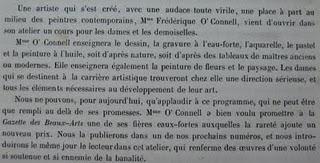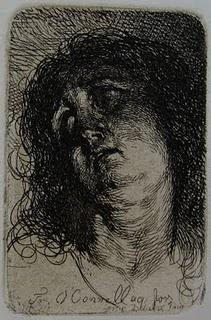 Frédérique Émilie O'Connell: Prospectus of studies
Frédérique Émilie O'Connell: Prospectus of studiesShe exhibited at the Paris Salon from 1846 to 1868. The collapse of the Second Empire in 1870 was also the end of Frédérique Émilie O'Connell's artistic career, as the demand for society portraits dwindled. Abandoned by both her husband and her society friends, Frédérique Émilie O'Connell lost her grip on reality, and spent her final years in a mental hospital, forgotten and alone. This sad end eclipsed what had been a glittering career for this pioneering woman artist. Frédérique Émilie O'Connell is now remembered less for her portraits and history paintings than for her skill as an etcher. Although she made only 10 etchings in all, they are a remarkable body of work. She made her first etchings in Brussels in 1849; the last, a self-portrait, was published by L'Artiste in 1879, though probably executed well before that (the other 9 were already catalogued by Philippe Burty in 1860). Burty's favourite among O'Connell's etchings was the Tête de sainte Madeleine published by the Gazette des Beaux-Arts in 1860. He writes of this work (which is also known simply as Tête de femme), that it is "the most beautiful work ever etched by Mme O'Connell. The swagger of the effect, and the sureness of the line make this sketch a masterful etching worthy of the greatest Flemish masters."
 Frédérique Émilie O'Connell, Tête de sainte MadeleineEtching, c.1849
Frédérique Émilie O'Connell, Tête de sainte MadeleineEtching, c.1849One thing that is hard to convey in this format is how tiny this etching is - just 80 mm high and 50 mm wide (roughly 3" by 2"). The rest of her etchings are more generous in size, but the small proportions of the Tête de Sainte Madeleine emphasise both the delicacy and panache of her etched line. As with many etchers of the time, Frédérique Émilie O'Connell looked to Rembrandt as the greatest exponent of the art of etching, and her work mimics both his freedom and his precision. Although she was a member of the Société des Aquafortistes in 1862 and 1865, Frédérique Émilie O'Connell only published one etching with Cadart, a portrait of her husband dressed as a knight of the time of Louis XIII.

